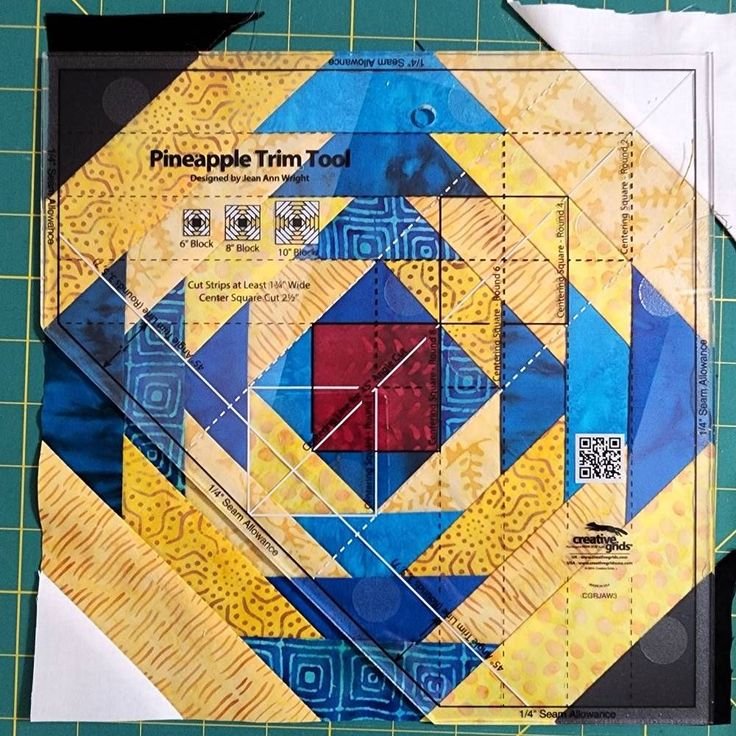The Pineapple Quilt Block is a beloved and intricate design that has captivated quilters for generations. This classic pattern, a variation of the Log Cabin block, is known for its dynamic, radiating effect and complex appearance. Despite its detailed look, it can be mastered with patience, practice, and the right techniques.
In this article, we will explore the history, techniques, and variations of the Pineapple Quilt Block, providing valuable tips to help you create a stunning quilt.
Whether you are a beginner or an experienced quilter, this guide will walk you through the essentials of crafting a perfect Pineapple Quilt Block.

1. The History and Significance of the Pineapple Quilt Block
The Pineapple Quilt Block has a long and fascinating history, dating back to the early days of quilting in America. Its name is derived from the resemblance of the layered fabric pieces to the segments of a pineapple, which historically symbolizes hospitality and warmth.
- This pattern became popular during the 19th century and was widely used in both decorative and functional quilts.
- The Pineapple design is considered a variation of the Log Cabin quilt block, but with added complexity due to its diagonal fabric placement.
- Quilters have traditionally used this design to create visually striking pieces with high contrast between light and dark fabrics.
- Many antique Pineapple Quilt Blocks are hand-stitched, showcasing the skill and patience of past generations.
- Today, modern quilting techniques make it easier than ever to create a Pineapple quilt with precision and efficiency.
- Whether using traditional methods or digital sewing patterns, quilters continue to cherish this classic block for its timeless appeal.
2. Materials and Tools Needed for a Pineapple Quilt Block
To create a beautiful Pineapple Quilt Block, gathering the right materials and tools is essential. With proper preparation, the process becomes smoother and more enjoyable.
- Fabric Selection: Choose high-quality quilting cotton in contrasting colors to highlight the intricate pattern.
- Rotary Cutter and Cutting Mat: A sharp rotary cutter ensures clean fabric cuts, while a mat protects your workspace.
- Quilting Ruler: A precise ruler helps in measuring and cutting fabric pieces accurately.
- Sewing Machine with Quarter-Inch Foot: A quarter-inch foot ensures consistent seam allowances, crucial for quilt accuracy.
- Iron and Pressing Board: Pressing fabric between sewing steps helps to achieve crisp and professional-looking seams.
- Foundation Paper (Optional): Some quilters prefer foundation paper piecing to maintain precision and prevent fabric distortion.
3. Step-by-Step Guide to Making a Pineapple Quilt Block
Now that you have your materials ready, let’s go through the process of constructing a Pineapple Quilt Block step by step.
- Step 1: Cut Your Fabric – Start by cutting fabric strips of varying widths, ensuring contrast between light and dark colors.
- Step 2: Create the Center Square – Begin with a small center square as the foundation of your block.
- Step 3: Add the First Round of Strips – Sew strips around the center square, trimming as needed to maintain straight edges.
- Step 4: Continue Adding Strips in a Log Cabin Style – Gradually build outwards, ensuring alignment and symmetry.
- Step 5: Press Seams as You Go – Consistently press seams to one side or open to prevent bulkiness.
- Step 6: Trim the Block to Maintain Precision – Use a quilting ruler to square up the block and achieve a uniform size.
4. Tips for Mastering the Pineapple Quilt Block
Even experienced quilters can benefit from practical tips and tricks when working on a Pineapple Quilt Block. Here are some helpful insights to improve accuracy and efficiency.
- Use a Light and Dark Color Contrast – High contrast enhances the intricate design of the block.
- Work with Foundation Paper Piecing for Precision – This technique prevents fabric stretching and maintains accuracy.
- Chain Piecing for Efficiency – Speed up the sewing process by stitching multiple blocks at once.
- Test Your Seam Allowance – A consistent 1/4-inch seam allowance ensures all pieces align perfectly.
- Trim Excess Fabric Regularly – Keeping edges clean improves block accuracy.
- Practice on Scrap Fabric First – Before starting your final quilt, practice on scrap pieces to perfect your technique.
FAQ About Pineapple Quilt Block
1. What is the best fabric for making a Pineapple Quilt Block?
High-quality quilting cotton works best due to its durability and ease of handling.
2. Can beginners make a Pineapple Quilt Block?
Yes! While it looks intricate, with patience and practice, beginners can successfully create this block.
3. Do I need to use foundation paper piecing?
Not necessarily, but it helps with precision, especially for beginners.
4. How do I ensure my Pineapple Quilt Block is symmetrical?
Use a quilting ruler and carefully trim each round to maintain alignment.
5. What size should my Pineapple Quilt Blocks be?
Common sizes range from 6 inches to 12 inches, depending on the project.
6. Can I sew a Pineapple Quilt Block by hand?
Yes, but using a sewing machine speeds up the process and ensures consistency.
Creating a Pineapple Quilt Block is a rewarding experience that combines creativity with technical skill. By following the right steps, choosing quality materials, and using recommended techniques, you can craft a beautiful and precise quilt block. Whether you’re making a single block for a sampler quilt or an entire quilt top, mastering this pattern is a fantastic addition to your quilting expertise.
We hope this guide has provided valuable insights and inspiration for your quilting journey. Have you tried making a Pineapple Quilt Block before? Share your experiences, feedback, and suggestions in the comments below!
 Skip to content
Skip to content
